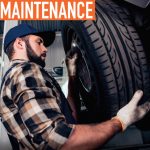Steering and suspension are two of the most important systems on any commercial vehicle. Power steering systems help increase steering stability and handling, while suspension systems help maintain proper contact with the road’s surface. Both systems play a crucial role in the efficient operation and safety of today’s trucks.
International Roadcheck continues to be a critical part of the Commercial Vehicle Safety Alliance’s (CVSA) strategy for keeping our highways safe. Aside from an increase in the number of inspections completed, Roadcheck isn’t much different from inspections performed before and after this three day event. What changes each year is the CVSA’s special emphasis on a category of violations, and this year the safety awareness event focuses on steering and suspension.
Like any other system on a truck, scheduled maintenance and routine inspections on your steering and suspension can help increase your safety and productivity and reduce your chances of being placed out-of-service.
POWER STEERING
Power steering systems use a series of pivoting joints and connected levers to react to the driver’s directional command. Most trucks today use hydraulics to achieve this, which reduces the amount of energy needed to turn the wheel, allowing drivers to safely and steadily maintain control when changing direction.
Power steering systems primarily consist of a hydraulic pump, which compresses hydraulic fluid to deliver the high pressure needed to power the system’s other main component, the steering gear box. The gear box then transfers the movement from the steering shaft to the steering linkages to provide power steering. Smaller components such as the pitman arm, drag link, tie rod ends, arms, and couplers work together to help transition the steering gear output to the front tires in order for you to steer your vehicle.
SUSPENSION SYSTEMS
Suspension systems are crucial in protecting commercial vehicles, their occupants, and cargo from irregularities on the road’s surface. In short, they help support and cushion the vehicle’s load during operation.
This system has a huge impact on the driver’s ability to control the truck on rough terrain, especially throughout turns. The suspension system is primarily made up of leaf or air springs, U-bolts, and shocks that work together to absorb the vertical movement of the axles to help reduce road shock.
While they operate as two separate systems, steering and suspension work hand in hand to maintain stability and control during braking and acceleration, keeping the vehicle safe on the road. This is especially important for today’s diesel-powered trucks that carry and transport heavy loads.
ROAD PREP
When your steering system doesn’t function properly, it can impact the safety and overall performance of the vehicle. Fortunately, identifying steering issues is fairly easy when you know what to look for.
Pay close attention to vibrations from the steering wheel, as this can indicate that a part in the system is excessively worn or not operating properly. Some vibrations originate from the wheel ends of the truck and work their way through the axle and eventually to the steering wheel. Look for any signs of fluid leaks in the power steering system during pre- and post-trip inspections, and if found, have them repaired by a professional technician before you head back out on the road. You should also have your power steering filter changed per the manufacturer’s recommended schedule. This filter is often overlooked, which can result in premature wear of the gear box and power steering pump.
Likewise, when mechanical components in your suspension system are no longer at OEM specifications, the system may not provide the stability and control needed to comfortably and safely transport your next load.
If you feel an unusual bouncing or jumping in the front end of the truck, this could indicate you have a weak or inoperative shock or spring in the front suspension system. If you notice vibrations coming from the driver’s seat or floor of the truck, this could mean that the rear air spring valves were incorrectly adjusted or installed. In either case, poorly installed air springs can cause intense harmonic vibrations to radiate into the transmission and, in some cases, the rear of the engine, affecting more than just the truck’s suspension. Have these vibrations looked at by a certified technician immediately if you suspect or notice a malfunctioning spring or shock.
ROAD READY
Ensure both your steering and suspension systems are ready for the road ahead with routine pre- and post-trip inspections. Look for any signs of fluid leaks in the power steering system and listen for air leaks in the suspension’s air spring system. If you notice any worn or loose components or feel any unusual vibrations or bouncing coming from your wheel or driver’s seat, have both systems inspected by a trusted service provider. Technicians should also check these systems during scheduled PMI and DOT inspections.
Power steering and suspension systems are crucial in supporting the heavy loads transported by today’s trucks. The more quickly you react to any unusual vibrations or shaking coming from your truck, the more likely you are to have a safe route. Not to mention, you’ll hopefully avoid being placed out of service.
ABOUT THE AUTHOR
Homer Hogg is the director of TA Truck Service Technical Service. He holds an ASE Medium/Heavy Duty Truck Master certification, is a Daimler Trucks North America Dealer Trainer, and is a co-host on SiriusXM’s “Maintenance Matters.” Find out more, visit www.ta-petro.com.
MODERN WORKTRUCK SOLUTIONS: MAY 2019 ISSUE
Did you enjoy this article?
Subscribe to the FREE Digital Edition of Modern WorkTruck Solutions magazine.





